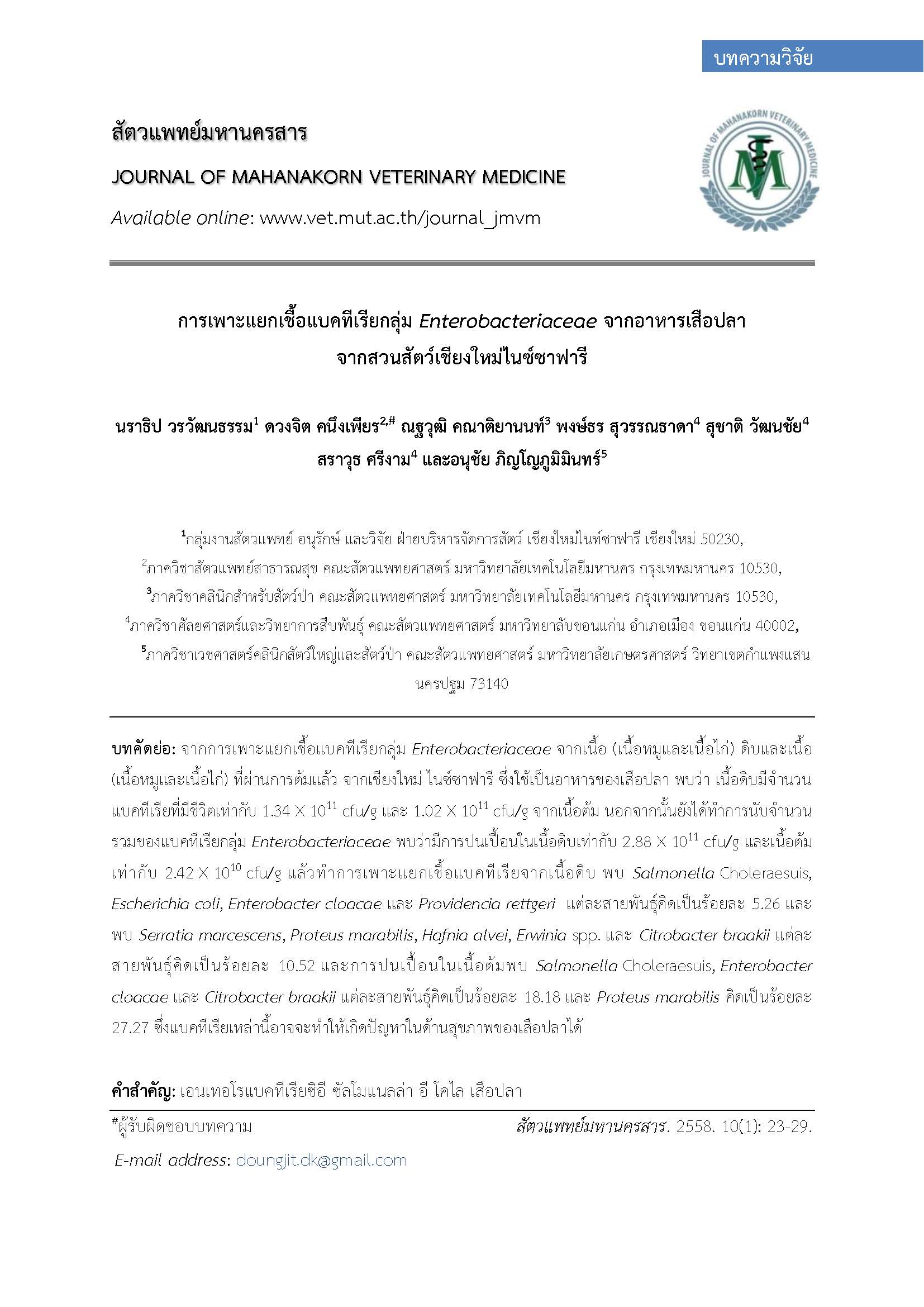The Isolation of Enterobacteriaceae in Fishing Cat (Prionailurus viverrinus) Food from Chiang Mai Night Safari
Main Article Content
Abstract
The isolation of Enterobacteriaceae was isolated from raw meat (pork and chicken meat) and cooked meat (pork and chicken meat) of fishing cat food. The total bacterial colony count is 1.34 X 1011cfu/g isolate form raw meat and 1.02 X 1011cfu/g from cooked meat. The total Enterobacteriaceae colony count were cultured from raw meat and cooked meat that found 2.88 X 1011 cfu/g and 2.42 X 1010 cfu/g respectively. Regarding bacterial isolation and identification from raw meat were found Salmonella Choleraesuis, Escherichia coli, Enterobacter cloacae and Providencia rettgeri which were 5.26% of each species. For Serratia marcescens, Proteus marabilis, Hafnia alvei, Erwinia spp. and Citrobacter braakii were found 10.52% of each species. In cooked meat were found 18.8% Salmonella Choleraesuis, Enterobacter cloacae and Citrobacter braakii of each species and 27.27% Proteus marabilis. These bacteria may lead to health problem of fishing cats.
Article Details
References
นงลักษณ์ สุวรรณพินิจ และปรีชา สุวรรณพินิจ. 2550. จุลชีววิทยาทั่วไป. สำนักพิมพ์แห่งจุฬาลงกรณ์มหาวิทยาลัย. กรุงเทพฯ. 6: 733 หน้า.
เพชรรัตน์ ศักดินันท์ สุกัญญา นาคสุนทร และเจษฏา จุลไกวัลสุจริต.2548. การตรวจหาซัลโม- เนลล่าปนเปื้อนในเนื้อสุกร เนื้อไก่ และเนื้อโคในภาคตะวันตกของประเทศไทย. ศูนย์วิจัยและพัฒนาสัตวแพทย์ภาคตะวันตก. ราชบุรี. 1-9.
วลัยพร ตนพิทักษ์. 2551. แบคทีเรียทางสัตวแพทย์. สำนักพิมพ์มีนเชอร์วิสซัพพลาย. กรุงเทพฯ. 450 หน้า.
สุบัณฑิต นิ่มรัตน์. 2552. การจำแนกแบคทีเรียแกรมลบ รูปท่อน วงศ์เอนเทอโรแบคทีเรียซีอี. สำนักพิมพ์แห่งจุฬาลงกรณ์มหาวิทยาลัย. กรุงเทพฯ. 132 หน้า.
สนทนา มิมะพันธ์. 2541. เอกสารประกอบการสัมมนาทางวิชากร โรคที่สำคัญที่เป็นปัญหาในระบบทางเดินอาหารสุกร. สถาบันสุขภาพสัตว์แห่งชาติ กระทรวงเกษตรและสหกรณ์. กรุงเทพฯ 60 หน้า.
Al-Mutairi, M.F. 2011. The incidence of Enterobacteriace causimg food poisoning in some meat product. J. Food Sci. Technol. 3(2): 116-121.
Baylis, C., Uyttendaele, M., Joosten, H. and Davies, A. 2011. The Enterobacteriaceae and their significance to the food industry. Inter. Life Sci. Insti. 1: 4-52.
Brooks, G.F., Butel, J.S. and Morse, S.A. 2001. Jawetz, Melnick, & Adelberg's Medical Microbiology 22nd Edition. McGraw-Hill. 248-261.
Grimont, F. and Grimont, P.A.D. 2006. The Genus Serratia. Prokaryotes. 6: 219-244.
Hendriksen, R.S. 2003. Kits for identification of Enterbacteriaceae using API. World Health Organization. 4: 1-8.
Miranda, J.M., Guarddon, M., Vazqvus, B.I., Fente, C.A., Barros-Velazquez, J., Cepeda, A. and Franco, C.M. 2008. Antimicrobial resistance in Enterobacteriaceae strains isolated from organic chicken, conventional chicken and conventional turkey meat: A comparative study. J. Food control. 19: 412-416.
Sani, N.A. and Yi, L.Y. 2011. Enterobacteriaceae, Cronobacter (Enterobacter) sakazakii and microbial population in infant formula products in the Malaysian. J. Sains Malaysiana. 40(4): 345-351.


